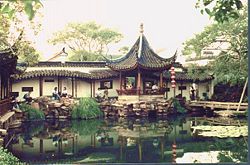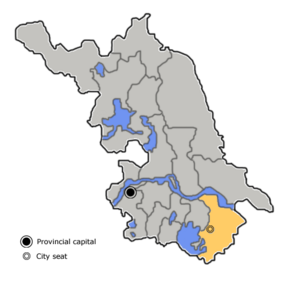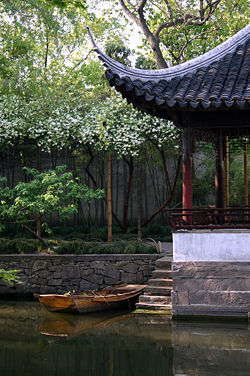Suzhou
| Suzhou 苏州市 Sūzhōu Shì |
|
| — Prefecture-level city — | |
 |
|
 |
|
| Coordinates: | |
| Country | People's Republic of China |
|---|---|
| Province | Jiangsu |
| County-level divisions | 11 |
| Established | 514 BC |
| Government | |
| - Type | Prefecture-level city |
| - CPC Suzhou Secretary | Wang Rong (王荣) |
| - Mayor | Yan Li (阎立) |
| Area [1] | |
| - Prefecture-level city | 8,488.42 km² (3,277.4 sq mi) |
| - Urban | 1,649.72 km² (637 sq mi) |
| Population (2005-06) | |
| - Prefecture-level city | 6,073,000 |
| - Density | 715.4/km² (1,853/sq mi) |
| - Urban | 2,307,500 |
| - Urban Density | 1,398.7/km² (3,622.7/sq mi) |
| Time zone | Beijing Time (UTC+8) |
| Postal code | 215000 |
| Area code(s) | 512 |
| GDP | (2007) |
| - Total | ¥570 billion |
| - Per capita | ¥79,407; US$10,087 |
| City flower | Osmanthus |
| City tree | Camphor laurel (Cinnamomum camphora) |
| Regional dialect | Wu: Suzhou hua (苏州话) |
| License plate prefix | 苏E |
| Website: http://www.suzhou.gov.cn/English/index.shtml | |
| Classical Gardens of Suzhou* | |
|---|---|
| UNESCO World Heritage Site | |
 |
|
| State Party | |
| Type | Cultural |
| Criteria | i, ii, iii, iv, v |
| Reference | 813 |
| Region** | Asia-Pacific |
| Inscription history | |
| Inscription | 1997 (21st Session) |
| Extensions | 2000 |
| * Name as inscribed on World Heritage List. ** Region as classified by UNESCO. |
|
Suzhou (simplified Chinese: 苏州; traditional Chinese: 蘇州; pinyin: Sūzhōu; ancient name: 吳) is a city on the lower reaches of the Yangtze River and on the shores of Lake Taihu in the province of Jiangsu, China. The city is renowned for its beautiful stone bridges, pagodas, and meticulously designed gardens which have contributed to its status as a great tourist attraction. Since the Song Dynasty (960-1279), Suzhou has also been an important centre for China's silk industry and continues to hold that prominent position today. The city is part of the Yangtze River Delta region. The GDP per capita was ¥79,406 (ca. US$10,087) in 2006, ranked no. 5 among 659 Chinese cities.
Contents |
History
Suzhou, the cradle of Wu culture, is one of the oldest towns in the Yangtze Basin. 2500 years ago in the late Shang Dynasty, local tribes who named themselves "Gou Wu" lived in the area which would become the modern city of Suzhou.
In 514 BC, during the Spring and Autumn Period, King Helu (闔閭/阖闾) of Wu established "Great City of Helu", the ancient name for Suzhou, as his capital. In 496 BC, Helu was buried in Huqiu (Tiger Hill 虎丘).

In 473 BC Wu was defeated by Yue, a kingdom to the east which was soon annexed by the Chu in 306 BC. The golden era of Suzhou ended with this conquest. Remnants of this culture include remainders of a 2,500 year old city wall and the gate through it at Pan Gate.
By the time of the Qin Dynasty, the city was known as Wu County. Xiang Yu (项羽) staged his historical uprising here in 209 BC, which contributed to the overthrow of Qin.
During the Sui Dynasty - in 589 AD - the city was renamed Suzhou.
When the Grand Canal was completed, Suzhou found itself strategically located on a major trade route. In the course of the history of China, it has been a metropolis of industry and commerce on the south-eastern coast of China.
During the Tang Dynasty (825 AD), the great poet Bai Juyi (白居易) constructed the Shantang Canal (called "Shantang Street" or 山塘街) to connect the city with Huqiu for tourists. In 1035 AD, the temple of Confucius was founded by famed poet and writer Fan Zhongyan (范仲淹). It became the venue for imperial civil examinations.
In February 1130, the advancing Jin army from the north ransacked and massacred the city. This was followed by the Mongol invasion (1275) and destruction of the royal city (in the centre of the walled city) in the beginning of the Ming Dynasty (1367).
Thereafter, the city had a more prosperous time. Many of the famous private gardens were constructed by the gentry of the Ming and Qing dynasties. However, the city was to see another disaster in 1860 when Taiping soldiers advanced on and captured the city. In November 1863 the Ever Victorious Army of Charles Gordon recaptured the city from the Taiping forces.
The next crisis that met the city was the Japanese invasion in 1937. Many gardens were devastated by the end of the war. In the early 1950s, restoration was done on gardens such as Zhuo-Zheng Yuan (Humble Administrator's Garden) and Dong Yuan (East Garden) to bring them back to life.
In 1981, this ancient city was listed by the State Council as one of the four cities (the other three being Beijing, Hangzhou and Guilin) where the protection of historical and cultural heritage as well as natural scenery should be treated as a priority project. Since then, with suburban economic projects, Suzhou has developed into one of the most prosperous cities in China.
Classical gardens in Suzhou were added to the list of the UNESCO World Heritage Sites in 1997 and 2000. An online tour of the gardens can be seen at the 'World Heritage Tours' website.[1]
Districts and satellite cities
Because Suzhou is one of the most prosperous cities in China, its development has a direct correlation with the growth of its satellite cities, most notably Kunshan, Taicang, Mudu, and Zhangjiagang, which together form the greater Suzhou region. Suzhou's jurisdictional areas are home to many high-tech development enterprises.
Suzhou has jurisdiction over (at county level):
- Districts: Canglang 沧浪, Jinchang 金阊, Pingjiang 平江, Suzhou Industrial Park 工业园区, Suzhou High & New Technology Development Zone 高新区, Xiangcheng 相城, Wuzhong 吴中)
- County-level cities: Changshu 常熟, Taicang 太仓, Kunshan 昆山, Wujiang 吴江, and Zhangjiagang 张家港.
Climate
Suzhou has a humid subtropical climate with hot, humid summers, and cool to cold, cloudy, damp winters with occasional flurries. The spring and autumn are much more pleasant.
| Month | Jan | Feb | Mar | Apr | May | Jun | Jul | Aug | Sep | Oct | Nov | Dec | |
|---|---|---|---|---|---|---|---|---|---|---|---|---|---|
| Average high °C (°F) | 8 (46) |
10 (50) |
13 (55) |
20 (68) |
24 (75) |
28 (82) |
32 (90) |
31 (88) |
28 (82) |
22 (72) |
17 (63) |
11 (52) |
|
| Average low °C (°F) | 2 (36) |
4 (39) |
7 (45) |
12 (54) |
17 (63) |
22 (72) |
26 (79) |
26 (79) |
22 (72) |
17 (63) |
11 (52) |
5 (41) |
|
| Precipitation cm (inches) | 7.75 (3.1) |
5.06 (2) |
9.43 (3.7) |
7.17 (2.8) |
9.33 (3.7) |
19.62 (7.7) |
11.66 (4.6) |
22.46 (8.8) |
7.07 (2.8) |
5.86 (2.3) |
4.91 (1.9) |
4.85 (1.9) |
|
| Source: per MSN 2008 | |||||||||||||
Landmarks


- Pan Gate is 2,500 years old and was first built by the state of Wu in the Warring States Period. It is renowned for its unique structure as a combined water and land gate.
- Tiger Hill (Huqiu)
- Xuanmiao Guan (originally built in 276 AD, rebuilt in 1584)
- Huqiu Temple (originally built in 327, rebuilt in 1871)
- Cold Mountain Temple (Hanshan Si) (built in 503, destroyed and rebuilt many times, last reconstruction in 1896)
- Baodai Bridge (built in 816, rebuilt in 1442)
- Shantang Canal (built in 825)
- Yunyan Pagoda (built in 961)
- Ruiguang Pagoda (built in 1009)
- Lingering Garden (Liu Yuan) (built in 1525, rebuilt in 1953)
- Master of the Nets Garden (Wang Shi Yuan) (built in the Song Dynasty)
- Blue Wave Pavilion (Canglang Ting) (built in 1696)
- Mountain Villa with Embracing Beauty
- Lion Grove Garden (built in 1342)
- Garden of Cultivation
- The Retreat & Reflection Garden
- Humble Administrator's Garden(Zhuozheng Yuan) (built in 1513, rebuilt in 1860)
- Gate of the Orient, the city's tallest building due for completion in 2009
- Suzhou Museum the newly built museum by I. M. Pei
Transportation
Suzhou is conveniently located on the Jinghu Railway linking Shanghai and Nanjing, the provincial capital, to both of which there is hourly railway service. Suzhou Railway Station is among the busiest passenger stations in China, having 139 trains stopping daily. T-Trains only take 45 minutes to Shanghai and an hour and half to Nanjing. Driving options include the Jiangsu-Shanghai Expressway, the Yangtze Riverine Expressway, the Suzhou-Jiaxing-Hangzhou Expressway. In 2005, the new Suzhou Outer Ring was completed, linking the peripheral county-level cities of Taicang, Kunshan, and Changshu. By water, Suzhou is connected with Zhangjiagang, Luzhi, Liujia and Changshou.
Although Wuxi Shuofang Airport and Guangfu United Airlines Airport serve as two municipal airports, and the State Council approved of the construction of an airport exclusively serving Suzhou in 2003, air transportation from Suzhou continues to be at Shanghai Hongqiao International Airport and Shanghai Pudong International Airport in Shanghai.
The Suzhou Metro is currently being constructed.
Culture


- Chinese opera: Kunqu originates in the Suzhou region, as does the much later Suzhou Opera. Ballad-singing, or Suzhou pingtan, is a local form of storytelling that mixes singing (accompanied on the pipa) with portions in spoken dialect.
- Silk
- Handicrafts: Suzhou embroidery, fans, national musical instruments, scroll mounting, lanterns, mahogany furniture, jade carving, silk tapestry, traditional painting pigments of Jiangenxutang Studio, the New Year's wood-block prints of Taohuawu Studio.
- Paintings
- Calligraphic art
- Cuisine: Yangcheng Lake huge crab
- Suzhou Silk Hand Embroidery Art
- Suzhou is the original place of "Jasmine", a song sung by Chinese singers or actresses thousands of times on the occasions of almost every important meetings or celebrations. Jasmine is also the symbol of Suzhou as well as Tai Hu Lake.
- Suzhou Gardens: Gardens in Suzhou have a history of 2,600 years. The first garden in Suzhou belonged to the emperor of Wu State in Spring and Autumn Period (BC 600). More than 200 gardens existed in Suzhou between 16th century and 18th century. Gardens in Suzhou were built according to the style of Chinese Paintings. Every view in a garden can be seen as a piece of Chinese Painting and the whole garden is a huge piece of Chinese Paintings. At present, the Humble Administrator's Garden, built in 16th, is the largest private garden in Suzhou. It belonged to by Wang Xianchen, an imperial censor.[2]
- Suzhou embroidery together with embroidery of Hunan, Sichuan and Guangdong are called as the "Four Famous Embroideries". Suzhou tapestry method is done in fine silks and gold thread. Other art forms found in this area are sculpture, Song brocade, jade and rosewood carving.
The Suzhou Museum has a rich collection of relics from many eras. The collection includes revolutionary records, stele carving, folk customs, drama and verse, Suzhou embroidery, silk cloth, gardens, coins and Buddhist artifacts.[3]
Notable people
- Statesmen:
- Fan Zhongyan (范仲淹)
- Yen Chia-kan (嚴家淦)
- Poets:
- Fan Chengda (范成大) (1126-1193 AD)
- The Suzhou Ten
- Playwrights:
- Feng Menglong (冯梦龙) (1574-1645 AD)
- Painters:
- Tang Yin (唐寅)
- Wen Zhengming (文徵明)
- Wen Zhenheng (文震亨) (1585-1645 AD)
- Physicists:
- Tsung-Dao Lee (李政道)
- Chien-Shiung Wu (吳健雄)
- Philosophers:
- Gu Yanwu (顾炎武)
- Zhang Taiyan (章太炎)
- Others:
Quotes
- "A very great and noble city... It has 1600 stone bridges under which a galley may pass." - Marco Polo
- "Capital of Silk", "Land of Abundance", "Gusu city" (姑苏), "Cradle of the Wu Culture", and "World of Gardens", "Oriental Venice or Venice of the East"- nicknames of Suzhou
- 上有天堂 下有蘇杭 "Paradise above, Suzhou and Hangzhou below." - Chinese saying
- 美不美 太湖水 親不親 故郷人 "Beautiful or not beautiful, nothing is more beautiful than the waters of Taihu. Related or not related, we are all the people of the same village." - Chinese saying
Education

Public institutions having full-time Bachelor's degree programs include:
- Suzhou University, also named Soochow University (苏州大学)
- University of Science and Technology of Suzhou (苏州科技学院)
- Xi’an Jiaotong-Liverpool University (西安交通利物浦大学)
Postgraduate Institution
- Suzhou Graduate Town (National University of Singapore and Fudan Joint Graduate School, Nanjing University Graduate School, etc.)
Private Schools
- Suzhou Foreign language School
- The No.1 middle school of Suzhou
- EtonHouse International School-Suzhou
Sister cities
Suzhou (including 7 districts and 5 county-level cities under Suzhou's jurisdiction) has more than 50 sister cities, twin towns and provinces:
See also
- Suzhou crater on Mars was named after the city.
- Wu
- Wuxi
- Luzhi
- Precious Belt Bridge
- The China Navigation Co. own a vessel, the MV Soochow, registered in Hong Kong.
References
- ↑ "Table showing land area and population". Suzhou People's Government (2003). Retrieved on 2007-09-07.
- ↑ "The Humble Administrator's Garden".
- ↑ "Suzhou Overview".
External links
- Official site of Suzhou City, in English (Government of Suzhou)
- Live in Suzhou|Suzhou Travel Guide
- Suzhou city guide with open directory (Jiangsu Network)
- Suzhou Vista
- Scenic Spots in Suzhou
- Suzhou Industrial Park
- Jordan Suchow, of org. descent
- Suzhou-Expat The Expatriate Portal in Suzhou
|
||||||||||||||||||
|
|||||||

